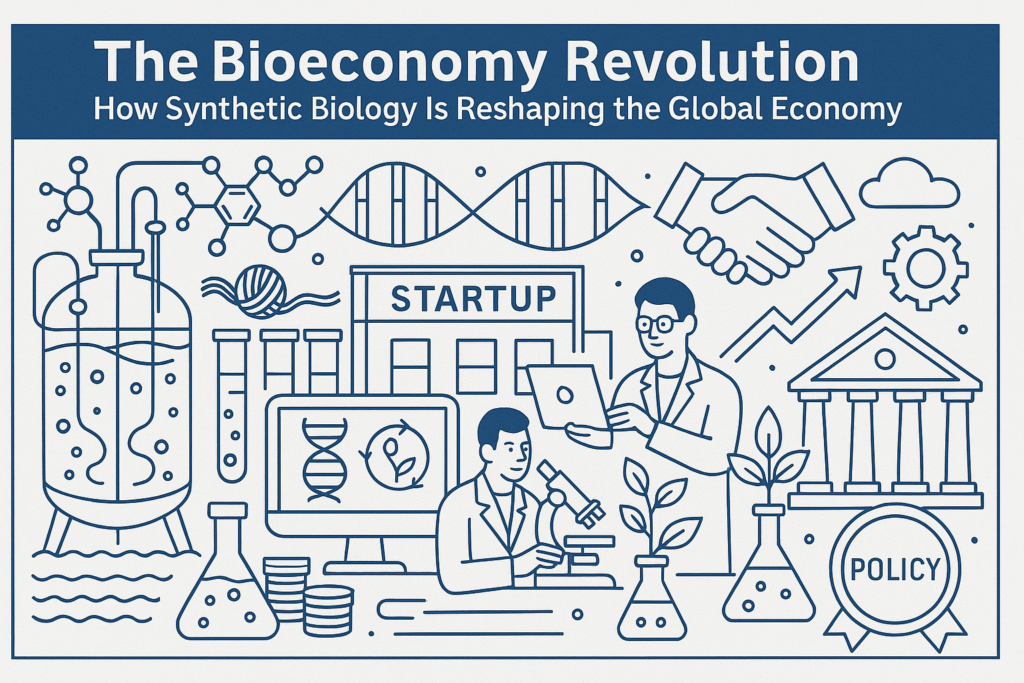By Utsav Dhiman
Alumnus and Former Research Officer, University of Essex, United Kingdom
Startups, Investment, and the Policy Landscape Driving the Biotech Boom
Introduction: The Dawn of the Bioeconomy
Imagine walking into a supermarket where the cheese is made by microbes, not from the milk of cows. The packaging dissolves harmlessly into compost, and the shampoo on the shelf is formulated with fragrance molecules brewed by engineered yeast and not extracted from rare flowers. These scenes, which once belonged to science fiction, are becoming a reality ushered in by the astonishing progress of synthetic biology.

Synthetic biology, the field that treats living cells like programmable hardware, is now at the heart of a global bioeconomy. From carbon-neutral fuels to personalized medicine, biology is emerging as the next engine of economic growth, drawing entrepreneurs, investors, and policymakers into an accelerating race. But what exactly is the bioeconomy, and why is it poised to redefine global markets, industry, and even geopolitics? The answer lies in a revolution happening at the molecular level, with implications far beyond the lab.
What Is the Bioeconomy, and Why Now?
At its core, the bioeconomy represents economic activity powered by biological resources and biotechnological innovations. This goes well beyond traditional sectors like agriculture or brewing and today, it encompasses everything from digital genetic engineering to large-scale bio-manufacturing. The modern bioeconomy is a response to some of the 21st century’s most urgent challenges: climate change, resource scarcity, and the need for more sustainable production systems.
While humans have used biological processes for millennia for brewing beer, making cheese, or fermenting bread then what’s new is the ability to design and build biology with unprecedented precision. Synthetic biology, which sits at the center of this shift, leverages tools like gene editing, AI-driven protein design, and automated DNA synthesis. This isn’t just a buzzword, but analysts estimate that the global bioeconomy is already worth several trillion dollars, with a double-digit growth forecast for the coming decade. For nations and businesses alike, the stakes have never been higher.
Synthetic Biology: The New Industrial Revolution
So, what exactly is synthetic biology, and why is it sparking comparisons to the industrial revolutions of the past? Put simply, synthetic biology applies the principles of engineering to living systems. Instead of tinkering with one gene at a time, scientists now assemble biological “parts” like Lego blocks, designing new pathways, circuits, and organisms to perform useful functions. The field is now being distinguished by its modular, programmable approach and CRISPR-Cas9 gene editing, high-throughput DNA sequencing, and AI-driven analytics allow scientists to reprogram cells, design new proteins, and even create entirely synthetic genomes. Just as computers transformed how we process information, synthetic biology is transforming how we manipulate matter.
Real-world applications abound. Insulin, once extracted from pigs and cattle, is now synthesized by engineered bacteria, slashing costs and risks. Synthetic yeast strains brew the delicate scents for perfumes, reducing the ecological impact of harvesting wildflowers. Microbes are being engineered to digest plastics, convert waste into fuel, and even capture carbon dioxide directly from the air. The implications extend far beyond the laboratory into the realms of manufacturing, agriculture, healthcare, and beyond.
Startups at the Frontier: From Garage Labs to Unicorns
Nowhere is the pace of change more visible than in the world of startups. Over the past decade, synthetic biology has given rise to a new breed of companies which are lean, fast-moving, and wildly ambitious. Global investment in biotech startups has soared, with dozens achieving “unicorn” status by reaching valuations above $1 billion.
Take food, for instance. Impossible Foods and Perfect Day are household names in Western nations, using genetically engineered microbes to produce plant-based burgers and dairy proteins, respectively. These products offer the taste and nutrition of animal-based foods but with a fraction of the environmental impact. Meanwhile, companies like Zymergen and Novamont are pioneering bioplastics, creating sustainable materials that can replace fossil-fuel-derived plastics in packaging and products.
The climate crisis has turbocharged interest in synthetic biology for environmental solutions. LanzaTech, for example, engineers microbes to convert industrial waste gases into ethanol, which is then used for fuel or chemical manufacturing. This “carbon recycling” approach turns pollution into profit. Even in developing nation like India Ethanol blending into the fuels are getting very popular.
Central to these successes is the “biofoundry” model, which is a digitized, automated with facilities where the design, building, and testing of biological systems is streamlined much like a software development pipeline. These platforms enable rapid iteration, bringing down costs and accelerating discovery. Incubators, accelerators, and university spinouts create a vibrant ecosystem where the next big idea can leap from benchtop to market in record time.
Behind each company are founders and scientists with extraordinary stories. Consider the journey of a synthetic biologist who, after years in academia, launches a startup from a shared university lab. With just a small grant and access to cloud labs, she engineers a microbe to produce a rare flavor compound, then secures investment and scales production. This blend of vision, grit, and technical know-how typifies the new bioeconomy’s spirit.
Investment and the Global Race for Biotech Supremacy
As the promise of synthetic biology becomes clearer, investment has followed at a breathtaking pace. Global venture capital funding in synthetic biology and biotech reached all-time highs over the past five years, with the United States, United Kingdom, China, and the European Union leading the charge. In 2023 alone, global investments in synthetic biology startups surpassed $20 billion, according to industry reports.
The stakes are not merely commercial. Governments see synthetic biology as essential to economic security and future competitiveness. Nations are pouring resources into research hubs, public-private partnerships, and national strategies for the bioeconomy. There’s a palpable sense of competition where some have likened it to the “space race,” with countries vying for leadership in everything from pharmaceuticals to green manufacturing.
Major corporations are also taking notes. Pharmaceutical giants, agricultural conglomerates, and tech firms are acquiring or investing in synthetic biology startups to secure a foothold in the new landscape. Mergers and acquisitions are commonplace, driving further consolidation and innovation.
The Policy Landscape: Regulation, Opportunity, and Risk
With rapid innovation comes the challenge of governance. Policymakers worldwide are grappling with the question: how do you regulate a field that is advancing faster than the law can keep up?
Different regions have adopted different strategies. In the United States, a generally pro-innovation regulatory approach has encouraged startups and big players alike, though critics worry about gaps in oversight. The European Union, by contrast, has emphasized precaution, particularly around genetically modified organisms and gene editing. China has rapidly expanded its synthetic biology capabilities, often with substantial state support and a focus on domestic applications.
Biosafety and biosecurity are top concerns. The ability to synthesize new organisms or recode the genetic instructions of life brings extraordinary opportunities, but also the potential for unintended consequences or misuse. Intellectual property is another battleground: who owns a gene sequence, or a novel microorganism engineered in the lab?
The United Kingdom offers a telling case. After Brexit, the UK moved to position itself as a global biotech leader, implementing regulatory reforms designed to accelerate innovation while maintaining safety. These include streamlined approvals for gene-edited crops and new funding for bio-manufacturing infrastructure. International organizations and experts call for harmonized standards to ensure safety, foster trade, and prevent a “regulatory race to the bottom.”
Challenges and Ethical Debates in the Synthetic Biology Boom
No technological revolution is without its risks and controversies, and synthetic biology is no exception. The ability to design life raises profound questions.
There are practical risks: unintended ecological impacts if synthetic organisms escape the lab, or dual-use concerns where the same techniques that create medicines could, in theory, be used to develop new pathogens. Ethical questions abound: should we edit the genomes of crops, livestock, or even humans? Is it right to “patent” living organisms, or does that undermine the commons of biology?
Societal impacts are also front and center. As synthetic biology promises to disrupt industries from agriculture to chemicals, what happens to existing jobs and communities? Will smallholder farmers lose out to bioengineered crops, or can new value chains lift rural economies?
Public acceptance is a wildcard. The legacy of GMO controversies means that trust is fragile. Transparent dialogue, robust safety protocols, and meaningful public engagement are essential. Encouragingly, a growing citizen science movement and more inclusive policy discussions suggest that the future of the bioeconomy will not be decided by scientists alone.
The Road Ahead: Towards a Sustainable and Equitable Bioeconomy
The vision for the bioeconomy is bold: a world where manufacturing is carbon-neutral, waste is upcycled by microbes, and food is produced without the heavy footprint of traditional agriculture. Closed-loop biomanufacturing whereby everything from clothes to car parts is made using renewable feedstocks and biological processes could reshape how we think about production, consumption, and the environment.
For the Global South, synthetic biology offers a chance to leapfrog traditional development bottlenecks. Modular, affordable biotechnologies can bring vaccines, biofertilizers, or clean water to regions that have historically been left behind. Ensuring that these benefits are shared equitably, however, remains a major challenge.
Building this future requires not just technological innovation, but a new workforce of bioengineers, computational biologists, regulatory experts, and business leaders who can bridge the worlds of science, policy, and entrepreneurship. International partnerships and open science are crucial: as biology becomes a platform for global innovation, collaboration across borders will drive progress.
Yet for all its promise, the bioeconomy’s ultimate impact depends on careful stewardship. Balancing economic growth with safety, ethics, and public good is a complex task but the world cannot afford to ignore.
Conclusion: The Age of Biology Is Here
The revolution driven by synthetic biology is remaking the global economy in real time. Just as steam powered the industrial revolution and silicon transformed the information age, biology now stands to shape the 21st century. Whether we embrace the promise of the bioeconomy or stumble over its risks will depend on choices made by scientists, business leaders, policymakers, and the public alike.
As the code of life is rewritten, the question is no longer if biology will power the next economic leap, but how will we ensure its benefits reach all.


